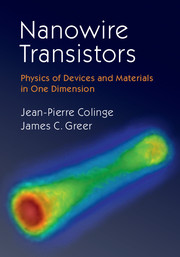Book contents
- Frontmatter
- Dedication
- Contents
- Preface
- 1 Introduction
- 2 Multigate and Nanowire Transistors
- 3 Synthesis and Fabrication of Semiconductor Nanowires
- 4 Quantum Mechanics in One Dimension
- 5 Nanowire Electronic Structure
- 6 Charge Transport in Quasi-1d Nanostructures
- 7 Nanowire Transistor Circuits
- Index
- References
1 - Introduction
Published online by Cambridge University Press: 05 April 2016
- Frontmatter
- Dedication
- Contents
- Preface
- 1 Introduction
- 2 Multigate and Nanowire Transistors
- 3 Synthesis and Fabrication of Semiconductor Nanowires
- 4 Quantum Mechanics in One Dimension
- 5 Nanowire Electronic Structure
- 6 Charge Transport in Quasi-1d Nanostructures
- 7 Nanowire Transistor Circuits
- Index
- References
Summary
The history of electronics spans over more than a century. A key milestone in the history of electronics was the invention of the telephone in 1876 and patents for the device were filed independently by Elisha Gray and Alexander Graham Bell on 14 February that same year. Bell filed first, and thus the patent was granted to him. This timely, or untimely for Gray, coincidence has become a textbook example for teaching the importance of intellectual property law in engineering schools across the globe.
Years later, the first radio broadcast took place in 1910 and is credited to the De Forest Radio Laboratory, New York. Lee De Forest, inventor of the electron vacuum tube, arranged the world's first radio broadcast featuring legendary tenor Enrico Caruso along with other stars of the New York Metropolitan Opera to several receiving locations within the city. Experimental television broadcasts can be traced back to 1928, but practical TV sets and regular broadcasts date back to shortly after the Second World War.
During this initial phase of development, electronics was based on vacuum tubes and electromechanical devices. The first transistor was invented at Bell Labs by William Shockley, John Bardeen, and Walter Brattain in 1947 and they used a structure named a point-contact transistor. Two gold contacts acted as emitter and collector contacts on a piece of germanium. William Shockley made and patented the first bipolar junction transistor in the following year, 1948. It is worth noting that the point-contact transistor was independently invented by German physicists Herbert Mataré and Heinrich Welker of the Compagnie des Freins et Signaux, a Westinghouse subsidiary located in Paris [1].
The first patent for a metal-oxide-semiconductor field-effect transistor (MOSFET) was filed by Julius Edgar Lilienfeld in Canada and in the USA during 1925 and 1928, respectively [2,3]. The semiconductor material used in the patent was copper sulfide and the gate insulator was alumina. However, a working device was never successfully fabricated or published at that time. The first functional MOSFET was made by Dawon Kang and John Atalla in 1959 and patented later in 1963 [4]. The successful field-effect operation was enabled by the use of silicon and silicon dioxide for the metal-oxide-semiconductor (MOS) stack.
- Type
- Chapter
- Information
- Nanowire TransistorsPhysics of Devices and Materials in One Dimension, pp. 1 - 17Publisher: Cambridge University PressPrint publication year: 2016



